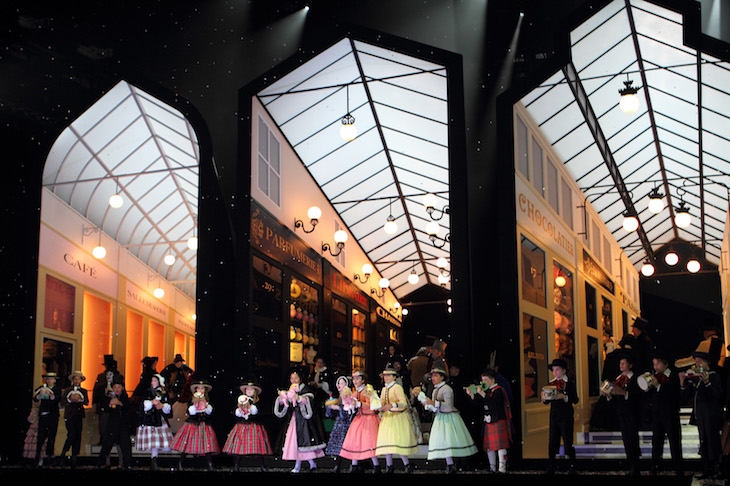The Royal Opera’s one production that, it has always confidently been claimed, need never be replaced has been replaced. John Copley, vintage 1974, has given way to Richard Jones, in a production full of his trademark quirkinesses and mischief, though he is respectful enough of Bohème to keep his irony out of sight for the last two acts. Stewart Laing is the designer, with a separate movement director (I thought that’s what directors did) in Sarah Fahie.
Snow falls continuously before the curtain rises, but the set of Act One inevitably strikes you as a gauntlet thrown down to Copley. Flat 7b, which is the abode of the bohemians, is nothing more than roof beams, with a single chair, no bed, a tiny stove that produces plumes of smoke emitted from a tall chimney. Clothes are charity shop, with touches of the 19th century. It’s not atmospheric, so the actors have to work hard to convince one that they are cold and hungry, and this team, though they have many virtues, don’t really do that. In fact, the first 20 minutes of laddish horseplay resolutely refuses to be fun either for them or for us, though the music bubbles and frisks along in a way irresistibly reminiscent of Falstaff’s opening scene (it had never struck me so forcibly before).
Once that prime operatic bore Benoît has been disposed of, and the bohemians leave with Rodolfo staying to finish an article — presumably standing up — the music undergoes its magical change, Mimì knocks and we’re off. Unfortunately, the lighting remains the same, cold white, so the two characters holding candles seems absurd. The act’s second half must be in semi-darkness; sitting just in front of Jones, I almost turned round to tell him.
Act One’s austerities give way to three luxurious shopping arcades, impressively solid-looking though proving to be quite restless, as contemporary directors like buildings to be. The usual Act Two romps take place in front of them, until they slide away and we’re in an upmarket Café Momus, far too expensive and lavish for the bohemians to be admitted, one would have thought. That, in turn, gives way to a street of 19th-century lamps. Meanwhile, the crowd does what the crowd always does, many members of it dressed to the nines — is a point being made? Act Three is desolation itself, the tavern being a small rundown hut. Rodolfo and Marcello exchange dreadful news about Mimì’s condition while she is in full view. Once again, snow has to do all the work. Act Four is back to 7b, now with a small couch. The bohemians get up to more convincingly merry pranks, though lack of props means that Marcello has to do his painting on to mere air. Musetta enters and the rest of the act is properly direct and ungimmicky.
What of the music? In an interview in last week’s Sunday Times, Antonio Pappano, who conducts, lapses effortlessly into management-speak, stating: ‘Star power is important to sell the product.’ But star power isn’t mainly what he has here — though the Rodolfo and Mimì will no doubt become stars after this. Pappano clearly loves this particular product, but not to death. His conducting is marvellously detailed but flowing, and changes of mood are managed with unostentatious precision.
His singers couldn’t ask for better support. There is one established star, Mariusz Kwiecien (Marcello), who is ideal in whatever he does, the most spontaneous of operatic actors. The Australian Nicole Car has previously sung for the Royal Opera in Holten’s detestable Eugene Onegin, where no one could make an impression. She is a demure Mimì, a decent actress with a lovely voice, if at the moment rather a small one. In her scenes with Rodolfo, especially in Act One, the American Michael Fabiano was consistently louder, but only within decent limits. His Act One aria was intoxicating, while Car’s answering one wasn’t quite that. The role of Musetta, which she will sing in some subsequent performances, may suit her better. Simona Mihai, the Musetta of this performance, will later sing Mimì, and would have made more of an impression in Act Two if there had been fewer visual distractions.
La bohème is indestructible, and this production certainly didn’t attempt to destroy it. It was more of a DIY affair in the main, with the audience being the Y. I cried at the end.






Comments